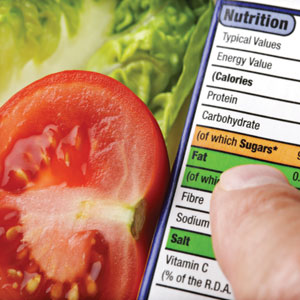Deciphering Food Labels

Before buying any packaged food, you must first read what’s on the box to understand what’s inside. So find the label of any packaged food in your pantry and follow along.
Serving Size: The nutritional value of each product is written according to serving size. If a serving size is for one cup and you eat two, all the information on the label must be doubled to get accurate values.
% Daily Value: This statement is required to be on all food labels and it will always be the same. Since it shows the recommended dietary allowance for all Americans, it does not change from product to product. These are based on a 2000-calorie diet. Most people don’t know how much they consume, so this is just a reference to help determine whether a food is high or low in a nutrient.
A daily value of 5 percent or less in a serving is considered low for nutrients. When consuming products such as fats, cholesterol, saturated fat, and sodium, make sure the daily value is no more than 5 percent. A daily value of 20 percent or more is considered high for nutrients. Look for 20 percent DV or more for vitamins, minerals and fiber (not for fats, sodium and cholesterol). Note that a percent DV is not listed for trans fats, sugars, and protein.
Calories and Calories from Fat: A calorie is a unit of energy that measures how much energy a food provides to the body. Most of us consume more calories than we need. On the average, women consume 1,800–2000 calories a day and men consume around 2,500 daily. Calories from fat are just that—the number of calories that come from fat. Remember, the number of servings you consume determines the total number of calories you eat.
Total Fat: This tells the total grams of fat in a single serving of food. Fats are an important source of energy and are required by our body every day. However, too much fat can cause obesity and other health problems. Total fat intake should be no more than 30 percent of your total calories. A product that has three grams or less of total fat (per serving) is considered low fat.
Saturated Fat: This is the bad fat that can raise blood cholesterol and increase your risk of getting heart disease. This number should be close to 0 percent.
Trans Fat: Another bad fat. All food labels are required by the FDA to report trans fats. However, if a food has less than 0.5 grams of trans fat per serving, it can be reported as “trans-fat-free.” This is why it’s important to pay close attention to how many servings you are eating, because if you eat several servings, the trans fats could add up even if it is a product labeled “trans-fat-free”! Aim for 0 percent here.
Cholesterol: The body needs some cholesterol to function, but too much of it can lead to heart disease. Eat less than 300 mg per day.
Sodium: The American Heart Association recommends no more than 2,300 mg of sodium per day. However, most of us easily consume around 4,000–5,000 mg every day!
Carbohydrates: Most Asian Indians follow a diet very high in carbohydrates. About 350 grams are recommended daily.
Dietary Fiber: We need about 25 grams/day of dietary fiber.
Sugars: There is no daily value established for sugars. Three to five grams of sugar per serving is considered low whereas 45 grams of sugar is considered very high.
Protein: Most Asian Indians consume low amounts of protein. Approximately 50–70 grams daily depending on body size or 12–20 percent of caloric intake is recommended.
Vitamins & Minerals: Food labels also provide information on important nutrients that should be consumed in greater amounts. Remember that 5 percent DV or less contributes little to the daily total, whereas 20 percent DV or more contributes a lot.
[Aarti Patel serves as the columnist for Fitness Lifestyle. She has a B.Sc. in Health Information Administration and is certified by the American Council on Exercise as a Personal and Group Fitness Instructor, and Lifestyle and Weight Management Coach. She can be reached at (404) 376-5655; info@aartifitness.com. This column rotates monthly along with the Ask the Doctor column by Gulshan Harjee, M.D.]
Enjoyed reading Khabar magazine? Subscribe to Khabar and get a full digital copy of this Indian-American community magazine.
blog comments powered by Disqus










